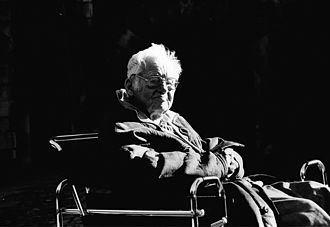Heinrich Heidersberger
Heinrich Heidersberger (born June 10, 1906 in Ingolstadt ; † July 14, 2006 in Wolfsburg ) was a German photographer who spent much of his life in Braunschweig and Wolfsburg ( Lower Saxony ).
Life
Heinrich Heidersberger met the later writer Eduard Zak during his school days in Linz , with whom he had a long friendship. Heidersberger graduated from high school in Linz in 1925 .
Heidersberger was based in Berlin and Braunschweig, among others, but his path also took him to Paris , Denmark , the Netherlands and the USA.
In 1928 Heidersberger began with photography, which from 1929 onwards almost exclusively devoted himself. In 1938 he took over the management of the picture department of the Reichswerke Hermann Göring in Salzgitter . In the post-war period he opened his own photo studio in Braunschweig.
Since 1961 he lived and worked constantly in Wolfsburg. From the start, his studio was at Wolfsburg Castle . At that time, Heidersberger founded the artist group Schloßstraße 8 together with other artists . The group no longer exists today. Heidersberger's divorced wife Renate Heidersberger-Weber (including the model of his work Kleid aus Licht ) has been running the experimental stage in the Antoniensaal at Wolfsburg Castle since 1968.
Heidersberger was best known as an industrial and architectural photographer . In 1998 the New York Museum of Modern Art asked the then 92-year-old for photos of the Alvar-Aalto-Kulturhaus in Wolfsburg. The experiment always appealed to him in his photographic work. His development of a light cannon in 1949 was spectacular in order to show undressed women in a series of pictures for the magazine Stern . In 1957 he was awarded a silver medal at the Milan Triennale for a pendulum machine for generating photographic rhythmograms . In 2003 Heinrich Heidersberger became an honorary citizen of the city of Wolfsburg.
Focus of work
-
photography
- Architectural photography
- Commercial and industrial photography
- Travel, reportage and documentation photography
- Rhythmograms
Works (selection)
- 1935: Copenhagen
- 1949: Dress made of light
- 1957: Benjamin
- 1962: Beetle and the castle (Wolfsburg)
- 1963: Wolfsburg - Pictures of a Young City
- 1971: Volkswagen AG power plant (Wolfsburg)
reception
Heidersberger Institute
The Heidersberger Institute was founded in 2002 to safeguard Heinrich Heidersberger's life's work and to make his works accessible to a broader public. To this end, his archive was processed with 60,000 negatives and 20,000 positives. The institute is sponsored by the city of Wolfsburg in recognition of Heidersberger's services. The institute is founded and managed by his son Benjamin Heidersberger and Bernd Rodrian.
100 years of Heinrich Heidersberger
Since Heinrich Heidersberger celebrated his 100th birthday in 2006, the “Heidersberger One Hundred” series of events took place in Wolfsburg, including the exhibition Views and Structures in the Wolfsburg Municipal Gallery . In 2008, two years after his death, the Kunstmuseum Wolfsburg presented his works in a six-month exhibition.
exhibition
- 2011: MS Atlantic, New York-Cuba , Kunstgut-Galerie, Hamburg
Web links
- Literature by and about Heinrich Heidersberger in the catalog of the German National Library
- heidersberger.de
- Overview of ongoing Heidersberger exhibitions
- The cosmopolitan Heinrich Heidersberger on kulturserver-nds
- New York-Cuba slideshow
- Information on Heinrich Heidersberger in the Deutsche Fotothek of SLUB Dresden
- Pictures by Heinrich Heidersberger in the Deutsche Fotothek
- Heidersberger's pendulum machine for generating the rhythmograms
- Heidersberger Institute at wolfsburg.de
Individual evidence
- ^ Before the storm: Heinrich Heidersberger's Kubabilder. weltkunst.de, accessed on June 7, 2020.
- ↑ Wolfsburg experimental stage - history. Retrieved October 25, 2016 .
- ↑ The American Cuba Dream in: Der Spiegel 13/2011
| personal data | |
|---|---|
| SURNAME | Heidersberger, Heinrich |
| BRIEF DESCRIPTION | German photographer |
| DATE OF BIRTH | June 10, 1906 |
| PLACE OF BIRTH | Ingolstadt |
| DATE OF DEATH | July 14, 2006 |
| Place of death | Wolfsburg |
